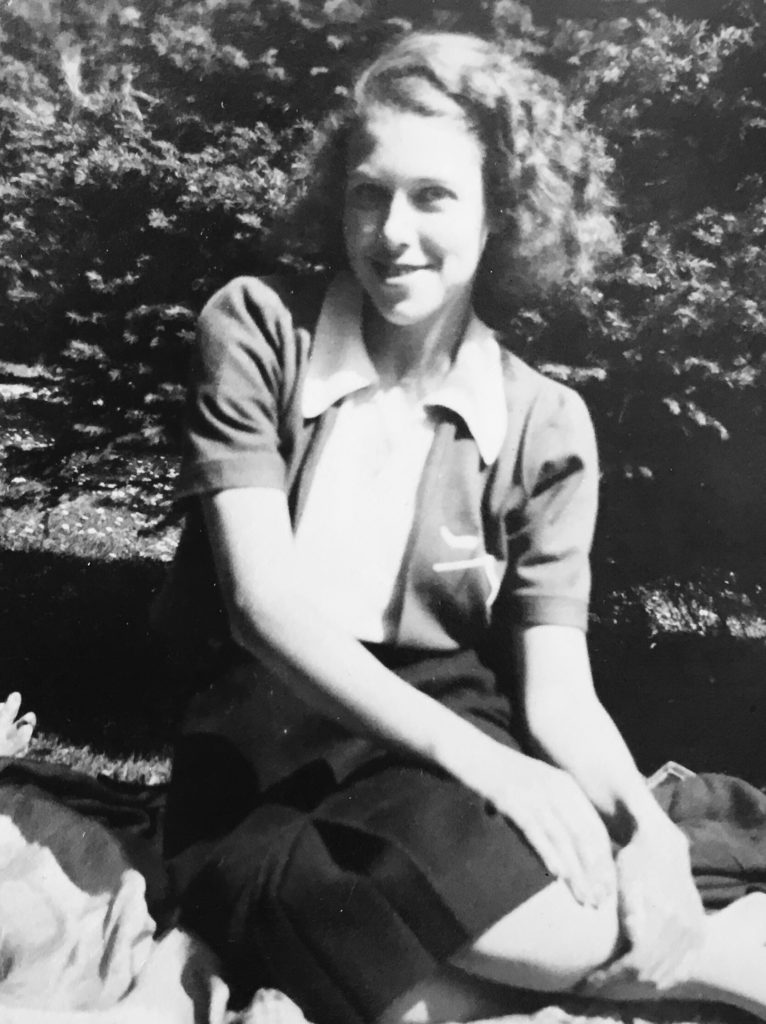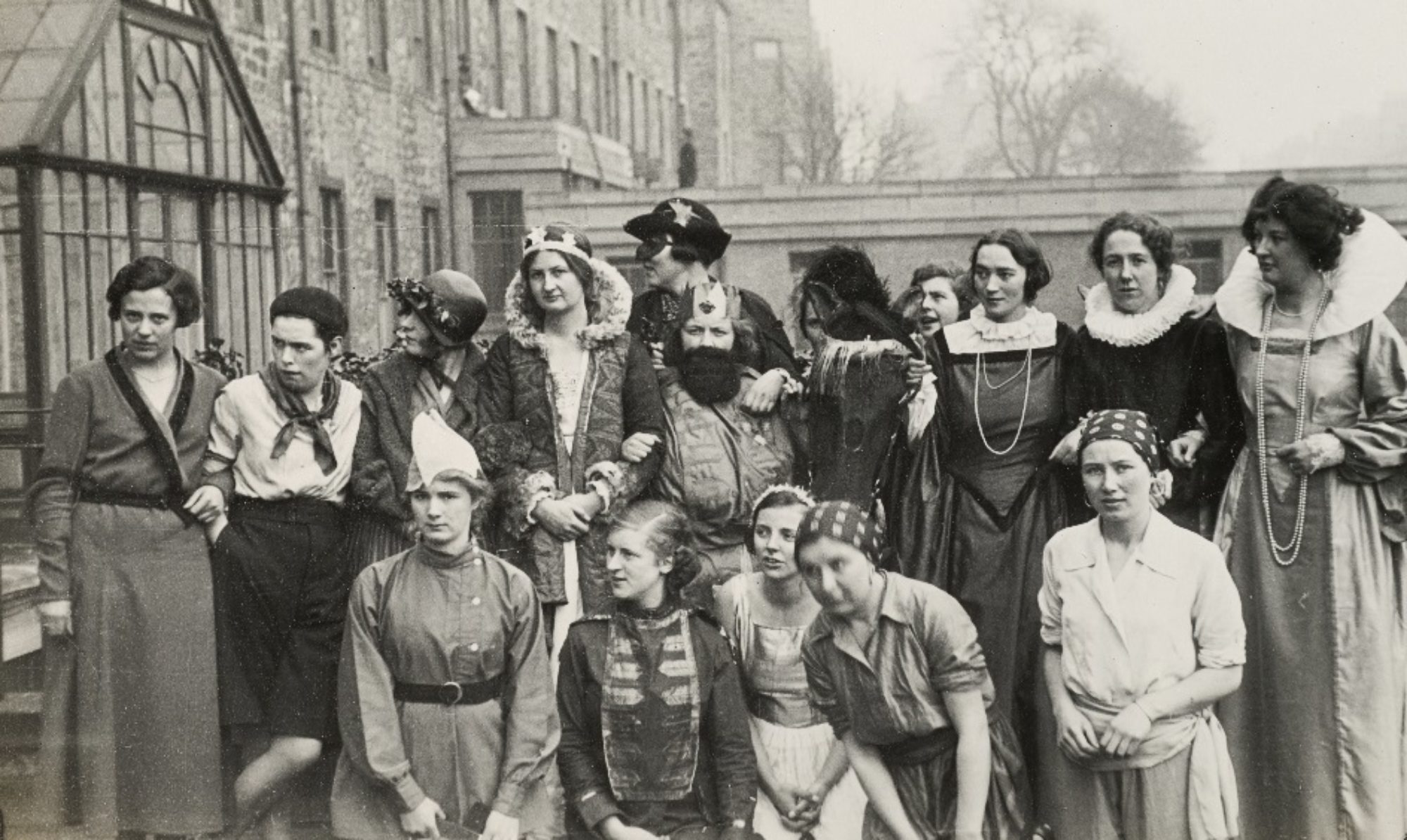
Irene J. Young, affectionately known by friends and family as ‘Mouse,’ was born in Edinburgh on 16th February 1919. She was educated at Esdaile (Ministers’ Daughters’ College) before joining The University of Edinburgh in 1937 to pursue an M. A. (Hons) degree in English Language and Literature.
Irene’s engagement in the war effort dates back to her time as a student in Edinburgh, where, in the summer of 1941, she begun work as a volunteer with ‘the Scheme for Provision of Shelter for Persons rendered Homeless as a result of enemy action.’ A scrapbook of Irene’s time at The University of Edinburgh, stored within the Centre for Research Collections, depicts Irene’s commitment to play a part in the home front resistance as well as her emotional involvement in the welfare of troops deployed both at home and abroad.
After her graduation in July 1942, Irene was recommended by members of the University for employment with the Foreign Office, work that eventually led her to take up a post at the Government Code and Cypher School (GC&CS) at Bletchley Park. Of her time at Bletchley, Irene wrote:
“I, among many others, was a mere adjutant –a cog in the great enterprise. We did the routine work which was, nevertheless, collectively essential.”
The ‘collectively essential’ work performed by Irene at the GC&CS was part of a top-secret operation, code-named Ultra, to obtain –through decryption— vitally important intelligence from enemy radio and teleprinter communications. Thanks to the strenuous works of ‘cogs’ like Irene, the end of the war in Europe is said to have been advanced by two years (1), potentially sparing countless lives.

On 29th December 1943, after a long and complex engagement, Irene married fellow Edinburgh University graduate Lieut. Leslie George Cairns, R. A. (Ayrshire Yeomanry), seconded Parachute Regiment, with a small ceremony in St. Cuthbert’s Memorial Chapel in Edinburgh. The couple’s happy ending, however, was destined to be short-lived, as barely six months after the wedding Lieut. Cairns went missing during a sabotaging expedition in France, and was later declared dead in action. The mysterious circumstances of Leslie’s death prompted Irene to embark, soon after the end of the war, on a frustrating journey to France in an attempt to uncover the truth of her husband’s final mission. Following a series of unsuccessful inquiries, Irene begun making plans to permanently leave Britain, eventually moving to South Africa in 1947.
Abroad, Irene worked as a bookseller and a lecturer. During her time in South Africa, she made the acquaintance of Reginald Brown, a British war veteran “who was extremely sensitive to [her] experience, and who, himself, had had a tough war.” The shared memories of war times encouraged a bond between Irene and Reginald which, soon, resulted in marriage. Not long after becoming husband and wife, the couple returned to Edinburgh, where Reginald found employment as an accountant, while Irene worked first as a freelance editor and tutor, before joining a department of Edinburgh University Library, where she remained for ten years.
Then, in 1982, “shortly after the Falklands War,” Reginald “died suddenly and unexpectedly”:
“I was desolate. Not for nothing is the word for ‘widow’ derived from the French ‘VIDE’.”
Out of Irene’s grief for the loss of her second husband, came the idea for a new project: a memoir detailing Irene’s memories of the war, her work at Bletchley Park, and her first love. In 1988, having worked on her autobiography for the best part of six years and with the 50th anniversary of the beginning of WWII fast approaching, Irene started accosting publishers. The path to publication proved not without obstacles, with some editors commenting, “Oh no! Not another war memoir!”, and others doubting the “viability” of the project on the basis that “you are not a household name.”

Yet, Irene persevered in her attempts, and in April 1989 she was finally able to announce to her friends Ronald and Dorothy:
“I have a big surprise for you –and for myself! The book I started writing some time ago –to fill the big void created by Reg’s death—is to be published early next year!”
Enigma Variations was published in May 1990, two years after Irene’s first letter to her publisher, Bill Campbell. Irene’s papers speak of her delight at being able to share the “3 enigmas in my life then”: work at Bletchley Park, a love story complicated by the need for constant secrecy, and “the enigma of Leslie’s fate.” By immortalising her experiences, Irene was able to give voice to a generation of young people whose passions and fears had been silenced by years of unanswered questions and strict confidentiality:
“The technical complexities of the Enigma machine, and the breaking of the code have been brilliantly explained by Ronald Lewin, Peter Calvocoressi and others. I am in no way competent to do this.
[…]
My book has a much humbler purpose. I wanted to set on record the grim but hilarious social conditions endured by the rank and file at BP [Bletchley Park]. […] I happen to think this a piece of social history that shouldn’t be lost, and that any interesting individual experience in historic times is worthy of being recorded.”
Although Irene might only have been ‘a cog in the great enterprise’ of public History, her personal history, the history of a woman of incredible vitality and character who relentlessly fought for what she believed to be right, portrays the struggles, the sufferings, and the victories of an entire generation. Irene’s memoir and papers shed light on the experience of the war not as a great national event, but as the daily life of common men and women whose losses, sacrifices and efforts served as the backbone for an entire country. As such, her painstaking recording remains an invaluable gift to future generations.

(1) Kahn, David (1997), The Codebreakers: The Comprehensive History of Secret Communication from Ancient Times to the Internet (2nd Revised ed.), New York: Simon & Schuster.



One Reply to “From Bletchley with Love: Irene J. Young”